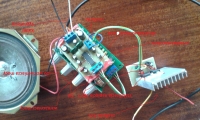Hello
Recently I have assembled a preamplifier from the AVT 1634 site. As an amplifier I used the ne530 kit with a 2x4W mini acoustic amplifier.
I have connected two 6W speakers to it, can it even work? Coming to the problem, the noise is heard through the speakers, not louder than the music being played, but it is a distraction when listening to it. This can be somehow compensated by a filter or maybe too strong speakers?
Thank you for all your help.
Recently I have assembled a preamplifier from the AVT 1634 site. As an amplifier I used the ne530 kit with a 2x4W mini acoustic amplifier.
I have connected two 6W speakers to it, can it even work? Coming to the problem, the noise is heard through the speakers, not louder than the music being played, but it is a distraction when listening to it. This can be somehow compensated by a filter or maybe too strong speakers?
Thank you for all your help.




